

C++ IO流_数据的旅行之路 - 一枚大果壳
source link: https://www.cnblogs.com/guo-ke/p/16635133.html
Go to the source link to view the article. You can view the picture content, updated content and better typesetting reading experience. If the link is broken, please click the button below to view the snapshot at that time.
程序中的数据总是在流动着,既然是流动就会有方向。数据从程序的外部流到程序内部,称为输入;数据从程序内部流到外部称为输出。
C++提供有相应的API实现程序和外部数据之间的交互,统称这类API为 IO 流API。
流是一个形象概念,数据从一端传递到另一端时,类似于水一样在流动,只是流动的不是水,而是数据。
概括而言,流对象可连接 2 端,并在两者之间搭建起一个通道 ,让数据通过此通道流过来、流过去。
2. 标准输入输出流
初学C++时,会接触 cout和cin 两个流对象。
2.1 简介
cout称为标准输出流对象,其一端连接程序,一端连接标准输出设备(标准输出设备一般指显示器),cout的作用是把程序中的数据显示在显示器上。

除了cout,还有cerr,其作用和 cout相似。两者区别:
-
cout带有数据缓存功能,cerr不带缓存功能。缓存类似于蓄水池,输出时,先缓存数据,然后再从缓存中输出到显示器上。 -
cout输出程序通用数据(测试,逻辑结果……),cerr输出错误信息。
另还有一个
clog对象,和cerr类似,与cerr不同之处,带有缓存功能。
cin 称为标准输入流对象,一端连接程序,一端连接标准输入设备(标准输入设备一般指键盘),cin用来把标准输入设备上的数据输入到程序中。

使用 cout和cin时需要包含 iostream头文件。
#include <iostream>
打开 iostream 源代码,可以看到 iostream文件中包含了另外 2 个头文件:
#include <ostream>
#include <istream>

且在 iostream头文件中可以查找到如下代码:
extern istream cin; /// Linked to standard input
extern ostream cout; /// Linked to standard output
extern ostream cerr; /// Linked to standard error (unbuffered)
extern ostream clog; /// Linked to standard error (buffered)
cout、cerr、clog是 ostream类的实例化对象,cin是 istream 类的实例化对象。
2.2 使用
ostream类重载了<< 运算符,istream类重载了>>运算符,可以使用这 2 个运算符方便、快速地完成输入、输出各种类型数据。打开源代码,可以查看到 <<运算符返回调用者本身。意味着使用 cout<<数据时,返回 cout本身,可以以链式方式进行数据输出。
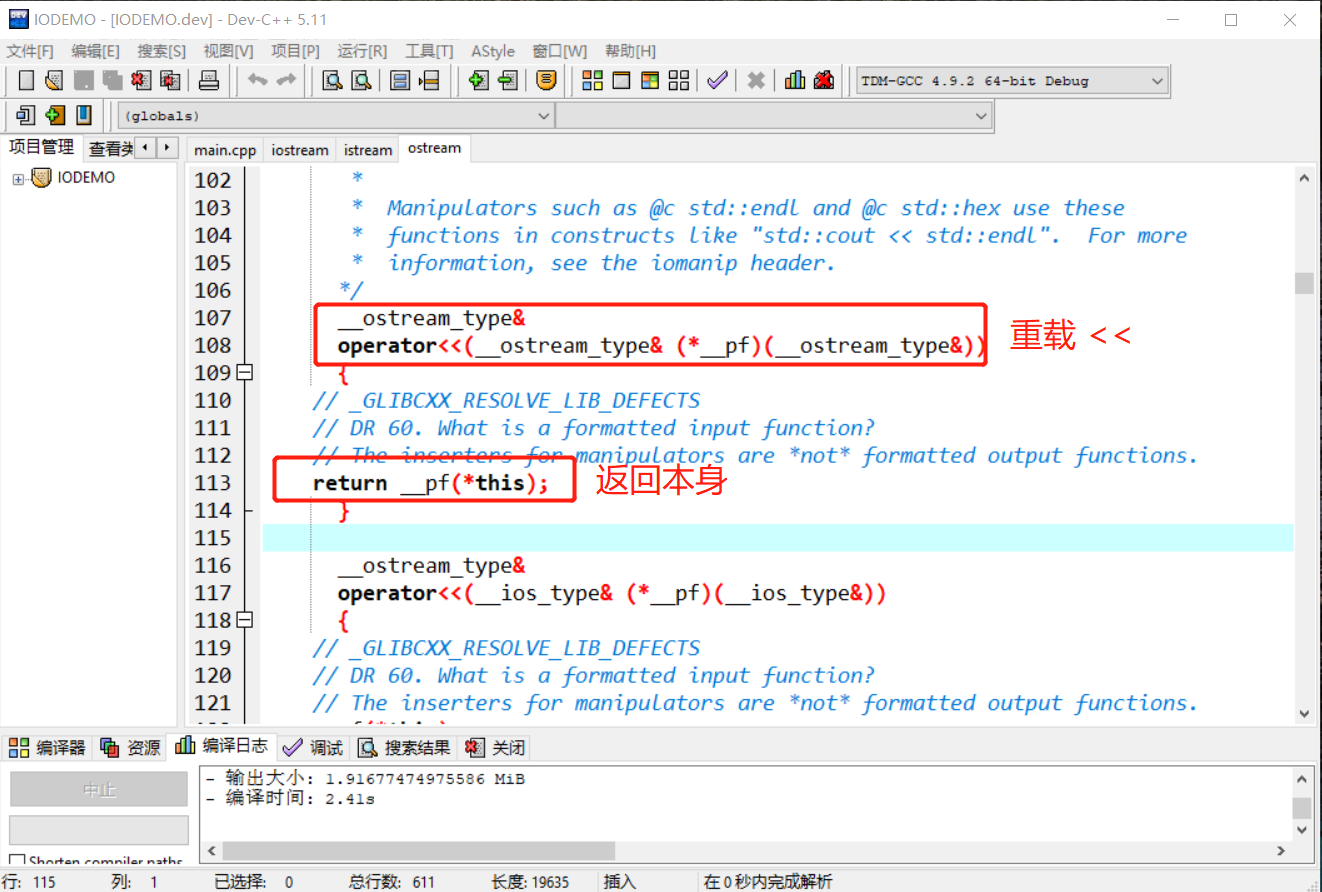
#include <iostream>
using namespace std;
int main(int argc, char** argv) {
string name="果壳";
int age=12;
//链式输出格式
cout<<"姓名:"<<name<<"年龄:"<<age;
return 0;
}
istream类重载了 >>运算符,返回调用者(即 istream 对象)本身,也可以使用链式方式进行输入。
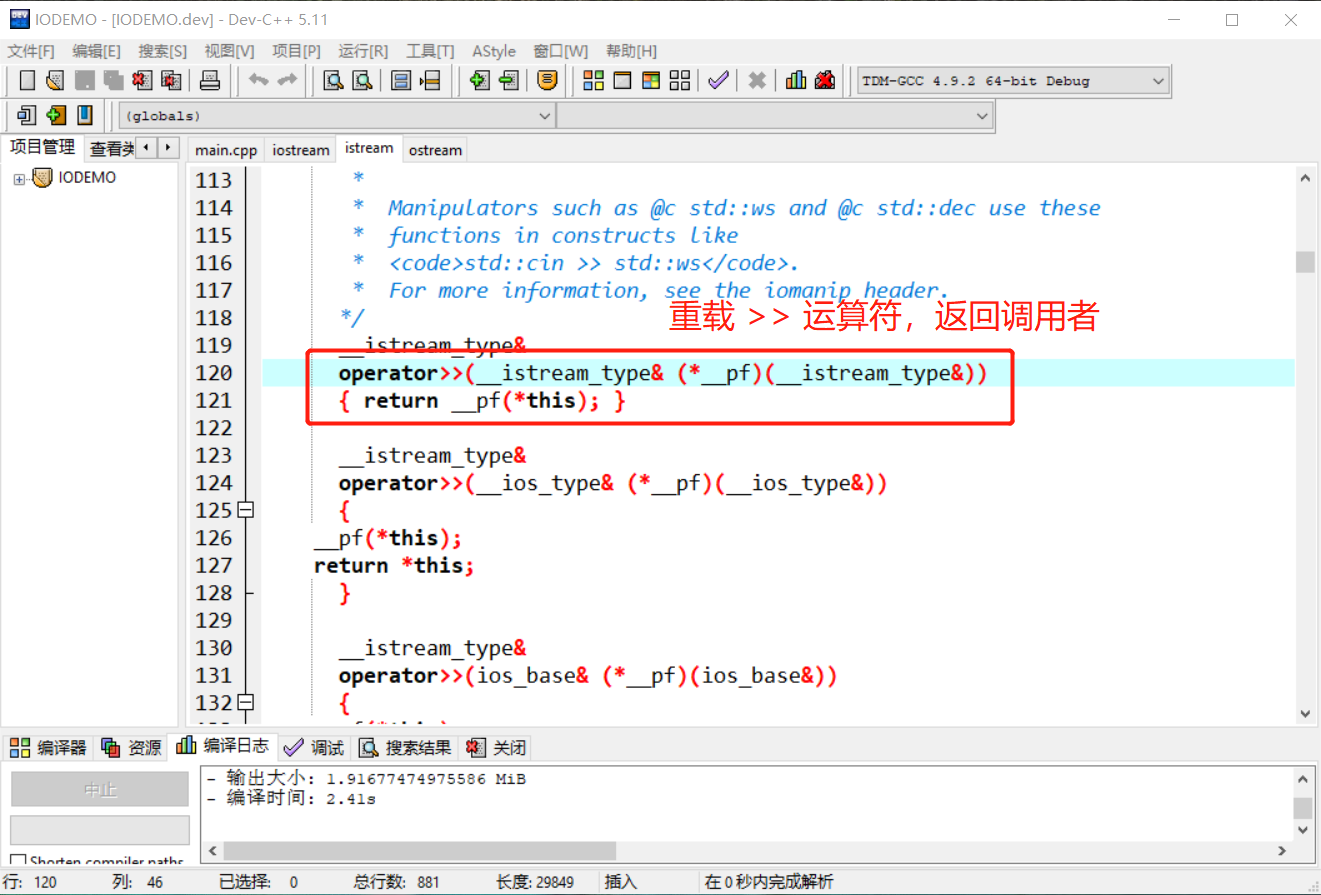
#include <iostream>
using namespace std;
int main(int argc, char** argv) {
char sex;
int age;
//链式输入
cin>>sex>>age;
return 0;
}
cout、cin 流对象的其它函数暂不介绍,继续本文的重点文件流。
3. 文件流
文件流 API完成程序中的数据和文件中的数据的输入与输出,使用时,需要包含 fstream头文件。
#include <fstream>
3.1 文件输入流
ifstream从 istream类派生,用来实现把文件中的数据l输入(读)到程序中。
输入操作对程序而言,也称为
读操作。
文件输入流对象的使用流程:
3.1.1 建立流通道
使用 ifstream流对象的 open函数建立起程序和外部存储设备中的文件资源之间的流通道。
文件类型分文本文件和二进制文件。

使用之前,了解一下 open函数的原型说明。打开ifstream头文件,可查看到 ifstream 类中有如下的信息说明:
template<typename _CharT, typename _Traits>
class basic_ifstream : public basic_istream<_CharT, _Traits>
{
/**
* @brief Opens an external file.
* @param __s The name of the file.
* @param __mode The open mode flags.
*
* Calls @c std::basic_filebuf::open(s,__mode|in). If that function
* fails, @c failbit is set in the stream's error state.
*
* Tip: When using std::string to hold the filename, you must use
* .c_str() before passing it to this constructor.
*/
void open(const char* __s, ios_base::openmode __mode = ios_base::in)
{
if (!_M_filebuf.open(__s, __mode | ios_base::in))
this->setstate(ios_base::failbit);
else
// _GLIBCXX_RESOLVE_LIB_DEFECTS
// 409. Closing an fstream should clear error state
this->clear();
}
#if __cplusplus >= 201103L
/**
* @brief Opens an external file.
* @param __s The name of the file.
* @param __mode The open mode flags.
*
* Calls @c std::basic_filebuf::open(__s,__mode|in). If that function
* fails, @c failbit is set in the stream's error state.
*/
void open(const std::string& __s, ios_base::openmode __mode = ios_base::in)
{
if (!_M_filebuf.open(__s, __mode | ios_base::in))
this->setstate(ios_base::failbit);
else
// _GLIBCXX_RESOLVE_LIB_DEFECTS
// 409. Closing an fstream should clear error state
this->clear();
}
#endif
}
ifstream重载了 open函数,2 个函数参数数量一致,但第一个参数的类型不相同。调用时需要传递 2 个参数:
- 第一个参数,指定文件的路径。第一个
open函数通过const char* __s类型(字符串指针)接受,第二个open函数通过const std::string& __s类型(字符串对象)接受。 - 第二个参数,指定文件的打开方式。打开方式是一个枚举类型,默认是
ios_base::in(输入)模式。打开模式如下所示:
enum _Ios_Openmode
{
_S_app = 1L << 0,
_S_ate = 1L << 1,
_S_bin = 1L << 2,
_S_in = 1L << 3,
_S_out = 1L << 4,
_S_trunc = 1L << 5,
_S_ios_openmode_end = 1L << 16
};
typedef _Ios_Openmode openmode;
/// 以写的方式打开文件,写入的数据追加到文件末尾
static const openmode app = _S_app;
/// 打开一个已有的文件,文件指针指向文件末尾
static const openmode ate = _S_ate;
/// 以二进制方式打开一个文件,如不指定,默认为文本文件方式
static const openmode binary = _S_bin;
/// 以输入(读)方式打开文件
static const openmode in = _S_in;
/// 以输出(写)方式打开文件,如果没有此文件,则创建,如有此文件,此清除原文件中数据
static const openmode out = _S_out;
/// 打开文件的时候丢弃现有文件里边的内容
static const openmode trunc = _S_trunc;
打开文件实现:
#include <iostream>
#include <fstream>
using namespace std;
int main(int argc, char** argv) {
ifstream inFile;
//文件路径保存在字符数组中
char fileName[50]="d:\\guoke.txt";
inFile.open(fileName,ios_base::in);
//文件路径保存在字符串对象中
string fileName_="d:\\guoke.txt" ;
inFile.open(fileName_,ios_base::in);
return 0;
}
除了直接调用 open函数外,还可以使用 ifstream的构造函数,如下代码,本质还是调用 open函数。
char fileName[50]="d:\\guoke.txt";
//构造函数
ifstream inFile(fileName,ios_base::in);
string fileName_="d:\\guoke.txt" ;
ifstream inFile(fileName_,ios_base::in);
可以使用ifstream的 is_open函数检查文件是否打开成功。
3.1.2 读数据
打开文件后,意味着输入流通道建立起来,默认情况下,文件指针指向文件的首位置,等待读取操作。
读或写都是通过移动文件指针实现的。
读取数据的方式:
- 使用
>>运算符。
ifstream是istream的派生类,继承了父类中的所有公共函数,如同 cin一样可以使用 >>运算符实现对文件的读取操作。
cin使用>>把标准输入设备上的数据输入至程序。
ifstream使用>>把文件中的数据输入至程序。两者的数据源不一样,目的地一样。
提前在 guoke.txt文件中写入如下内容,也可以用空白隔开数字。
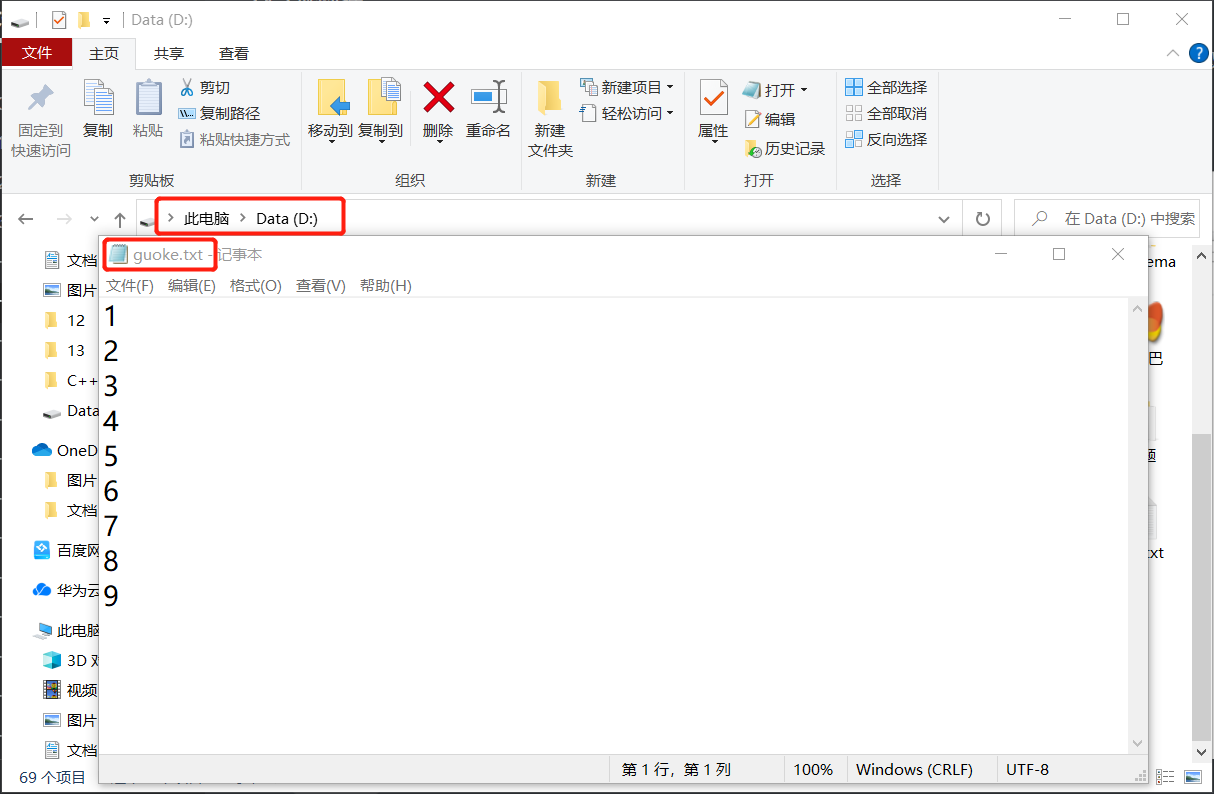
#include <iostream>
#include <fstream>
using namespace std;
int main(int argc, char** argv) {
//用来存储文件中的数据
int nums[10];
//文件输入流对象
ifstream inFile;
//文件路径
char fileName[50]="d:\\guoke.txt";
//打开文件
inFile.open(fileName,ios_base::in);
if(inFile.is_open()) {
//检查文件是否正确打开
cout<<"文件打开成功"<<endl;
//读取文件中的内容
for(int i=0; i<5; i++){
//读取
inFile>>nums[i];
//输出到显示器
cout<<nums[i]<<endl;
}
}
return 0;
}
如上代码,把文件中的 5 个数字读取到 nums 数组中。
用
>>运算符读取时,以换行符、空白等符号作为结束符。
- 使用
get、getline函数。
ifstream类提供有 get、getline函数,可用来读取文件中数据。get函数有多个重载,本文使用如下的 2 个。getline函数和get函数功能相似,其差异之处后文再述。
//以字符为单位读取
istream &get( char &ch );
//以字符串为单位读取
istream &get( char *buffer, streamsize num );
先在 D盘使用记事本创建 guoke.txt文件,并在文件中输入以下 2 行信息:
this is a test
hello wellcome
编写如下代码,使用 get函数以字符类型逐个读取文件中的内容。
#include <iostream>
#include <fstream>
using namespace std;
int main(int argc, char** argv) {
//用来存储文件中的数据
int nums[10];
ifstream inFile;
char fileName[50]="d:\\guoke.txt";
inFile.open(fileName,ios_base::in);
char myChar;
if(inFile.is_open()) {
cout<<"文件打开成功"<<endl;
//以字符为单位读取数据
while(inFile.get(myChar)){
cout<<myChar;
}
}
return 0;
}
//输出结果
this is a test
hello wellcome
读取时,需要知道是否已经达到了文件的未尾,或者说如何知道文件中已经没有数据。
-
如上使用
get函数读取时,如果没有数据了,会返回false。 -
使用
eof函数。eof的全称是end of file, 当文件指针移动到文件无数据处时,eof函数返回true。建议使用此函数。while(!inFile.eof()){ inFile.get(myChar); cout<<myChar; }
使用 get的重载函数以字符串类型读取。
#include <iostream>
#include <fstream>
using namespace std;
int main(int argc, char** argv) {
//用来存储文件中的数据
int nums[10];
ifstream inFile;
char fileName[50]="d:\\guoke.txt";
inFile.open(fileName,ios_base::in);
char myChar[100];
if(inFile.is_open()) {
cout<<"文件打开成功"<<endl;
while(!inFile.eof() ) {
//以字符串为单位读取
inFile.get(myChar,100);
cout<<myChar<<endl;
//为什么要调用无参的 get 函数?
inFile.get();
}
}
return 0;
}
输出结果:
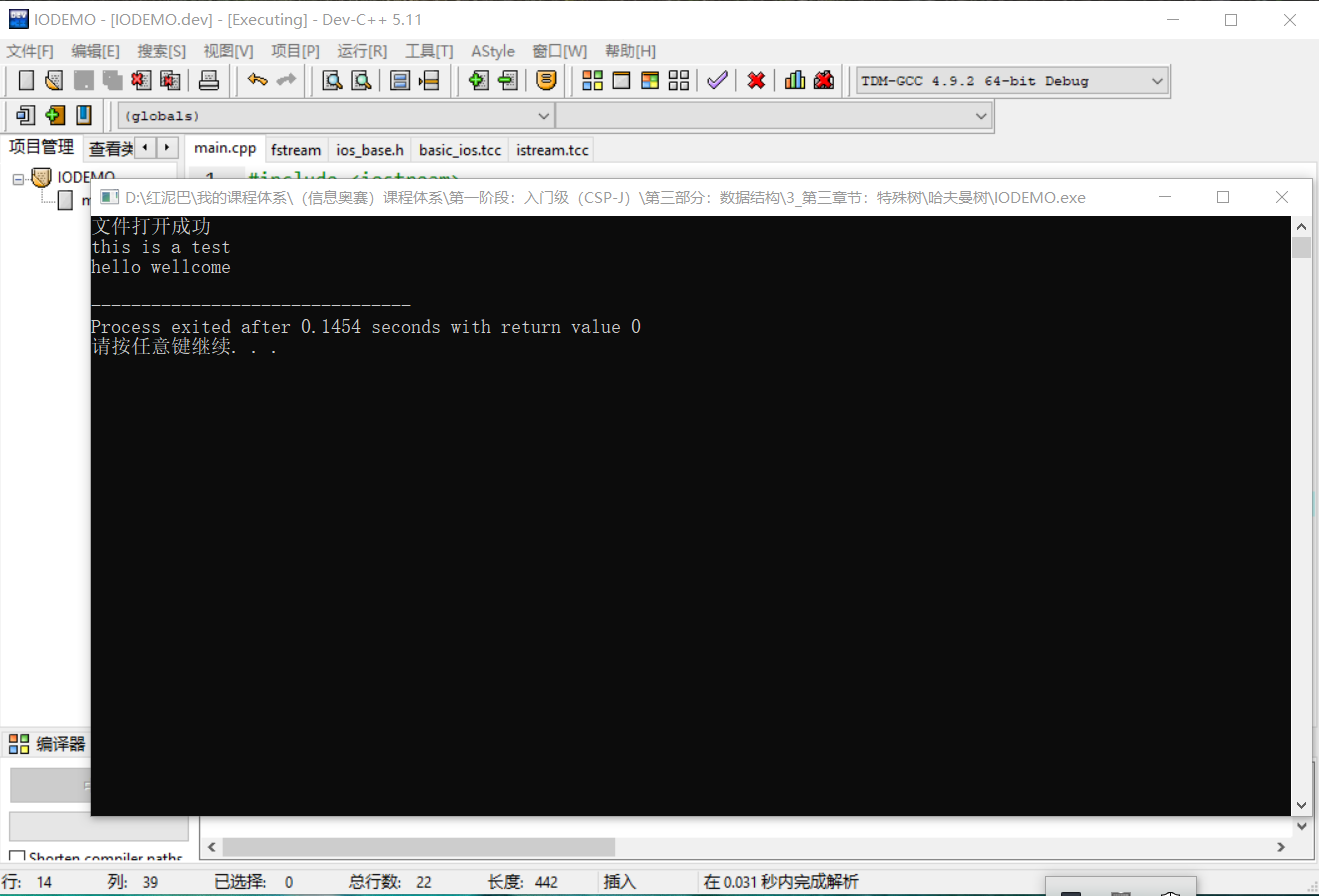
上述 get函数以字符串为单位进行数据读取,会把读出来的数据保存在第一个参数 myChar数组中,第二个参数限制每次最多读 num-1个字符。
如果把上述的
inFile.get(myChar,100);
inFile.get(myChar,10);
则程序运行结果如下:

第一次读了 9 个字符后结束 ,第二次遇到到换行符后结束,第三行读了 9 个字符后结束,第四行遇到文件结束后结束 。
为什么在代码要调用无参 get函数?
因为get读数据时会把换行符保留在缓存器中,在读到第二行之前,需要调用无参的 get函数提前清除(读出)缓存器。否则后续数据读不出来。
getline和 get函数一样,可以以字符串为单位读数据,但不会缓存换行符(结束符)。如下同样可以读取到文件中的所有内容。
while(inFile.eof()){
inFile.getline(myChar,100)
cout<<myChar<<endl;
}
- 使用
read函数。
除了get和getline函数还可以使用 read函数。函数原型如下:
istream &read( char *buffer, streamsize num );
#include <iostream>
#include <fstream>
using namespace std;
int main(int argc, char** argv) {
//用来存储文件中的数据
int nums[10];
ifstream inFile;
char fileName[50]="d:\\myinfo.txt";
inFile.open(fileName,ios_base::in);
char myChar[100];
if(inFile.is_open()) {
cout<<"文件打开成功"<<endl;
inFile.read(myChar,100);
cout<<myChar;
}
return 0;
}
read一次性读取到num个字节或者遇到 eof(文件结束符)停止读操作。这点和 get和getline不同,后者以换行符为结束符号。
3.1.3 关闭文件
读操作结束后,需要关闭文件对象。
inFile.close();
3.2 文件输出流
ofstream称为文件输出流,其派生于ostream,用于把程序中的数据输出(写)到文件中。和使用 ifstream的流程一样,分 3 步走:
- 打开文件。
使用 ofstream流对象的 open函数(和 ifstream的 open函数参数说明一样)打开文件,因为是写操作,打开的模式默认是ios_stream::out,当然,可以指定其它的如ios_stream::app模式。
#include <iostream>
#include <fstream>
using namespace std;
int main(int argc, char** argv) {
//输出流对象
ofstream outFile;
char fileName[50]="d:\\guoke.txt";
outFile.open(fileName,ios_base::out);
if (outFile.is_open()){
cout<<"打开文件成功"<<endl;
}
return 0;
}
- 写操作和读操作一样,有如下几种方案:
- 使用
<<运算符。
#include <iostream>
#include <fstream>
using namespace std;
int main(int argc, char** argv) {
//输出流对象
ofstream outFile;
char fileName[50]="d:\\guoke.txt";
outFile.open(fileName,ios_base::out);
if (outFile.is_open()){
cout<<"打开文件成功"<<endl;
for(int i=0;i<10;i++){
//向文件中写入 10 个数字
outFile<<i;
}
}
return 0;
}
输出结果:
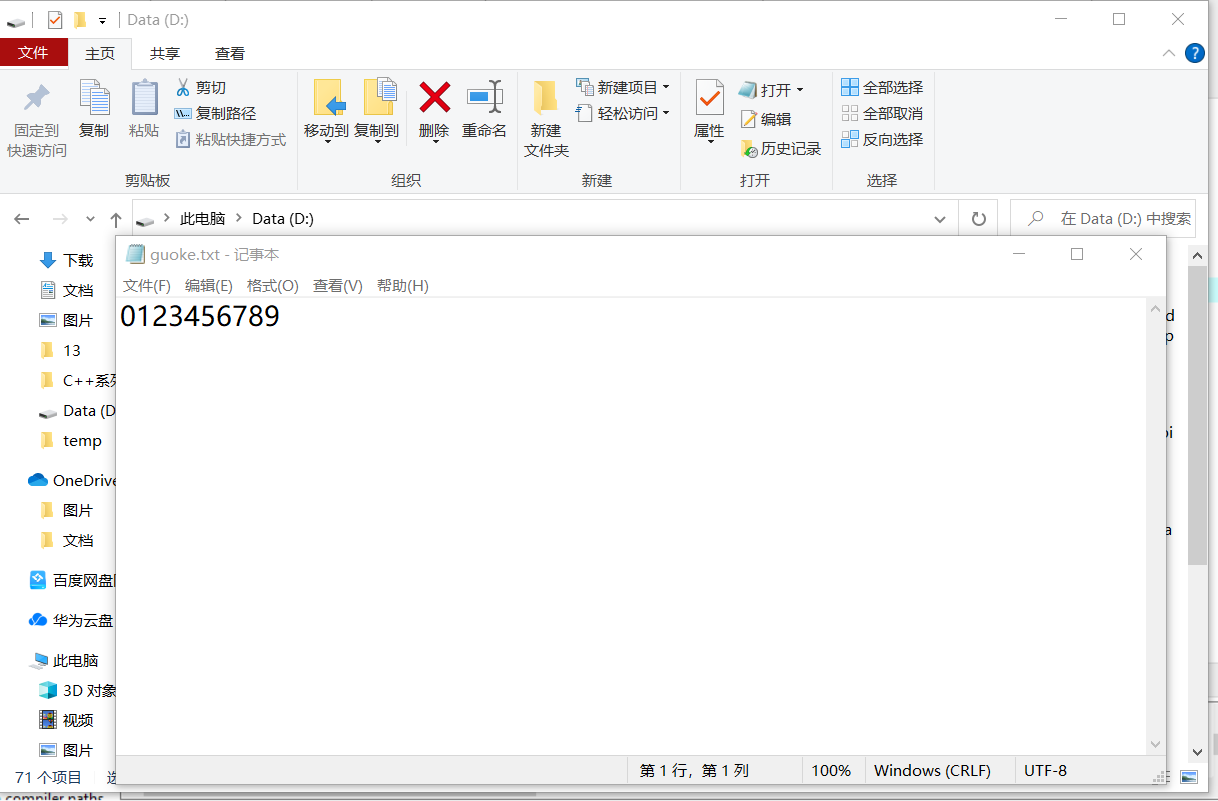
- 使用
put、write函数。
put函数以字符为单位向文件中写入数据,put函数原型如下:
ostream &put( char ch );
#include <iostream>
#include <fstream>
using namespace std;
int main(int argc, char** argv) {
//输出流对象
ofstream outFile;
char fileName[50]="d:\\guoke.txt";
outFile.open(fileName,ios_base::out);
if (outFile.is_open()){
cout<<"打开文件成功"<<endl;
for(int i=0;i<10;i++){
//写入 10 个大写字母
outFile.put(char(i+65) );
}
}
return 0;
}
write可以把字符串写入文件中,如下为write函数原型:
ostream &write( const char *buffer, streamsize num );
参数说明:
- 第一个参数:
char类型指针。 - 第二个参数:限制每次写入的数据大小。
#include <iostream>
#include <fstream>
using namespace std;
int main(int argc, char** argv) {
//输出流对象
ofstream outFile;
char fileName[50]="d:\\guoke.txt";
outFile.open(fileName,ios_base::out);
char infos[50]="thisisatest";
if (outFile.is_open()){
cout<<"打开文件成功"<<endl;
outFile.write(infos,50);
}
return 0;
}
文件中内容:
thisisatest
outFile.write(infos,50);
outFile.write(infos,5);
则文件中内容为
thisi
- 关闭资源。
操作完成后,需要调用close函数关闭文件。
outFile.close();
4. 随机访问文件
随机访问指可以根据需要移动二进制文件中的文件指针,随机读或写二进制文件中的内容。
随机访问要求打开文件时,指定文件打开模式为
ios_base::binary。
随机读写分 2 步:
- 移动文件指针到读写位置。
- 然后读或写。
随机访问的关键是使用文件指针的定位函数进行位置定位:
gcount() 返回最后一次输入所读入的字节数
tellg() 返回输入文件指针的当前位置
seekg(文件中的位置) 将输入文件中指针移到指定的位置
seekg(位移量,参照位置) 以参照位置为基础移动若干字节
tellp() 返回输出文件指针当前的位置
seekp(文件中的位置) 将输出文件中指针移到指定的位置
seekp(位移量,参照位置) 以参照位置为基础移动若干字节
如下代码,使用文件输出流向文件中写入数据,然后随机定位文件指针位置,再进行读操作。
#include<fstream>
#include<iostream>
using namespace std;
int main() {
int i,x;
// 以写的模式打开文件
ofstream outfile("d:\\guoke.txt",ios_base::out | ios_base::binary);
if(!outfile.is_open()) {
cout << "open error!";
exit(1);
}
for(i=1; i<100; i+=2)
//向文件中写入数据
outfile.write((char*)&i,sizeof(int));
outfile.close();
//输入流
ifstream infile("d:\\guoke.txt",ios_base::in|ios_base::binary);
if(!infile.is_open()) {
cout <<"open error!\n";
exit(1);
}
//定位
infile.seekg(30*sizeof(int));
for(i=0; i<4 &&!infile.eof(); i++) {
//读数据
infile.read((char*)&x,sizeof(int));
cout<<x<<'\t';
}
cout <<endl;
infile.close();
return 0;
}
原文件中内容:

代码执行后的运行结果,并没有输入文件中的所有内容。
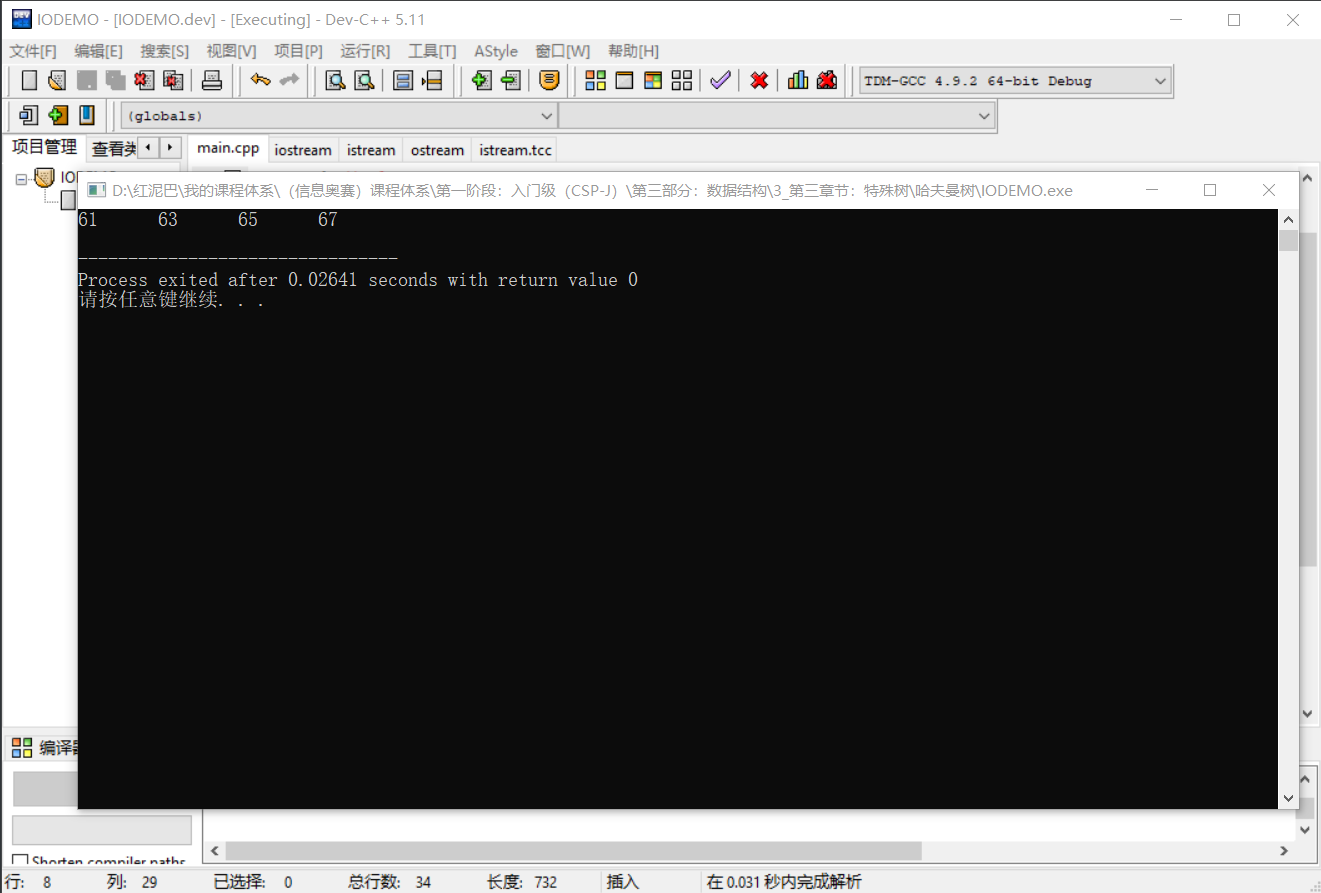
本文讲述了标准输入、输出流和文件流对象。
Recommend
About Joyk
Aggregate valuable and interesting links.
Joyk means Joy of geeK